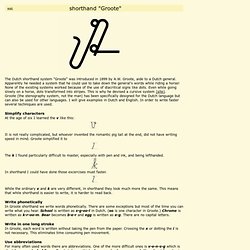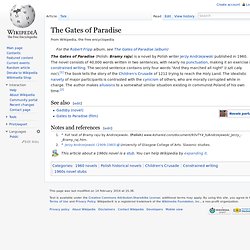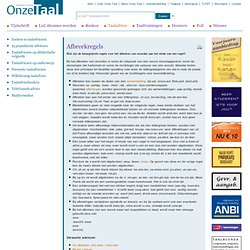

History of English Podcast. Shorthand "Groote" The Dutch shorthand system "Groote" was introduced in 1899 by A.W.

Groote, aide to a Dutch general. Apparently he needed a system that he could use to take down the general's words while riding a horse! None of the existing systems worked because of the use of diacritical signs like dots. Even while going slowly on a horse, dots transformed into stripes. This is why he devised a cursive system (site). Simplify characters At the age of six I learned the v like this: It is not really complicated, but whoever invented the romantic pig tail at the end, did not have writing speed in mind.
The k I found particularly difficult to master, especially with pen and ink, and being lefthanded. In shorthand I could have done those excercises must faster. While the ordinary v and k are very different, in shorthand they look much more the same. Write phonetically In Groote shorthand we write words phonetically. Write in one long stroke In Groote, each word is written without taking the pen from the paper. Ons Kortschrift. Shakespeare: Original pronunciation. Anyone have in insight on this turn of phrase in Josephus? (ἡττᾶσθαι πίστεως): Koine. The pun conundrum. 16 January 2013Last updated at 04:26 ET To pun or not to pun, that is the question.

The lowest form of wordplay, or an ancient art form embraced by the likes of Jesus and Shakespeare, asks Sally Davies. No pun is an island. Within less than a mile of my house in Brooklyn, a wanderer will find: Fish & Sip, a coffee and seafood joint Prospect Perk Cafe, an allusion to the restorative properties of caffeine and of nearby Prospect Park The Winey Neighbor, a liquor store that pays homage to the venerable New York tradition of grumbling about the noise from the apartment next door Where good humour and refreshments abound, puns seem to follow. Yet this neat little linguistic device - which exploits the multiple meanings of words or phrases that sound the same or similar - is considered by its detractors to be as irritating as it is irrepressible. Continue reading the main story A pun, or just a joke? Pun, noun. How did the pun acquire such a dubious reputation? Continue reading the main story. Constrained writing.
Constrained writing is a literary technique in which the writer is bound by some condition that forbids certain things or imposes a pattern.[1] Description[edit] Constraints are very common in poetry, which often requires the writer to use a particular verse form. The most common constrained forms of writing are strict restrictions in vocabulary, e.g. Basic English, copula-free text, defining vocabulary for dictionaries, and other limited vocabularies for teaching English as a Second Language or to children. This is not generally what is meant by “constrained writing” in the literary sense, which is motivated by more aesthetic concerns.
The Oulipo group is a gathering of writers who use such techniques. Examples[edit] Constrained writing. The Gates of Paradise. See also[edit] Notes and references[edit]

10 Language Mistakes Kids Make That Are Actually Pretty Smart. Little kids make such cute mistakes when they talk.

We know they're still learning the language, so we tolerate their errors and chuckle at how funny they sound. Behind that chuckle is the assumption that the kids are getting it wrong because they just don't know the rules yet. In fact, kids' mistakes show they know a lot more about the rules than we think. The mistakes are evidence of very smart hypotheses the kids are forming from the limited data they've been given so far. Here are 10 really smart language mistakes that kids make. 1. It's not easy to start a word with a consonant cluster. 2. When children start using words, they haven't figured out all the situations in which they apply. 3. This mistake shows complex knowledge of pragmatics, or the meaning of words in contexts.
Mi-xer / mix-er. Bij alle woorden vermeldt het Groene Boekje de plaatsen waar ze kunnen worden afgebroken.

Maar bij onder andere mixer staan geen afbreekpuntjes. Waarom is dat? Mixer mag niet worden afgebroken. Dat heeft te maken met de bijzondere behandeling die de x bij het afbreken krijgt. Voor en na een x die tussen klinkers staat, wordt namelijk niet afgebroken. Afbreekregels. Wat zijn de belangrijkste regels voor het afbreken van woorden aan het einde van een regel?

Bij het afbreken van woorden is soms de uitspraak van een woord doorslaggevend, soms de etymologie (de herkomst) en soms de morfologie (de opbouw van een woord). Meestal leiden deze drie principes tot dezelfde opvatting over waar de lettergreepgrens (en dat is vaak de plaats om af te breken) ligt. Hieronder geven we de hoofdregels voor woordafbreking. Afbreken kan tussen de delen van een samenstelling: bij-val, circus-act, fiets-pad, tand-arts. Woorden op -achtig, -baar, -heid, -rijk, -dom en -loos (achtervoegsels waarmee afleidingen worden gevormd) gedragen zich als samenstellingen: aap-achtig, bereik-baar-heid, ei-wit-rijk, prins-dom, werke-loos.
Verwante adviezen Trefwoorden. Buigings-e: het centraal / centrale station. Forlorn.